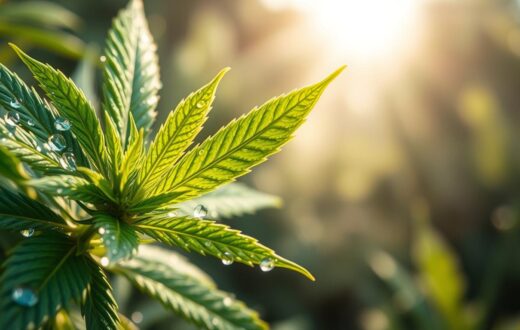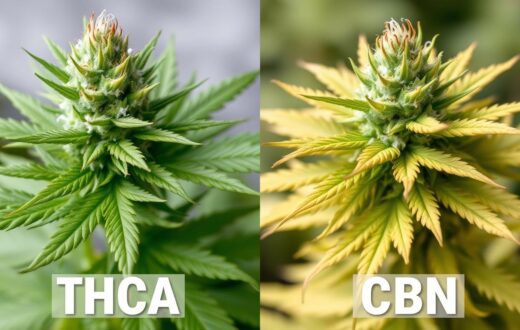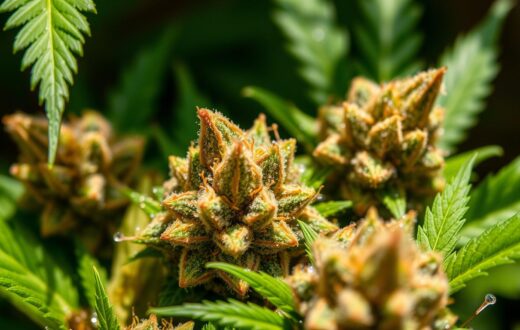Ever wondered how the cannabis industry makes those strong THC products? The secret is in THCA extraction methods. This process is changing how we use cannabis.
THCA is what turns into THC, the part that makes cannabis feel good. As more people want THC products, knowing about THCA extraction is key. It’s important for both users and those in the industry.
The cannabis world uses many ways to get high-purity concentrates. Methods like CO2, ethanol, and hydrocarbon help make THCA distillates. These can be up to 99% pure, offering great strength and quality.
But it’s not just about how strong it is. The goal is also to keep the plant’s natural flavors and smells. This makes sure we get a full experience. Products like live resin, rosin, and shatter all start with careful extraction.
Let’s dive into the science and techniques of THCA extraction. We’ll see what’s new and exciting in this fast-changing field. Get ready to learn about your favorite cannabis products!
Introduction to THCA Extraction
THCA extraction is a key part of cannabis processing. It isolates tetrahydrocannabinolic acid, a non-psychoactive compound in raw cannabis. This method is popular for its benefits and legal status in many places.
What is THCA?
THCA is the precursor to THC, the psychoactive part of cannabis. It’s found in fresh cannabis and turns into THC when heated. Unlike THC, THCA doesn’t cause a “high” effect.
Studies on mice suggest THCA might protect the brain. It could lower proteins linked to Alzheimer’s disease.
Importance of THCA Extraction
THCA extraction is vital for making strong, pure cannabis products. It’s a legal way to enjoy cannabis without THC’s effects. The 2018 Farm Bill made hemp products with less than 0.3% THC legal in most states.
This has made THCA more popular and available in the U.S. The cannabis industry uses different extraction methods. These include solvent-based and solventless techniques.
These methods create various THCA concentrates like diamonds, live resin, sauce, and crystalline. Each has its own texture and taste, meeting different consumer needs.
Common THCA Extraction Methods
THCA extraction uses several techniques, each with its own benefits. We’ll look at the top methods in the cannabis world today.
Solvent-Based Extraction
Solvent-based extraction is a common way to get THCA. It uses chemicals like ethanol or butane to pull cannabinoids from plants. It works well for big batches.
But, it needs careful handling to remove all solvent residue from the final product.
CO2 Extraction
Supercritical CO2 extraction is becoming more popular. It uses pressurized carbon dioxide to extract cannabinoids. It’s safer and leaves no toxic leftovers.
Hydrocarbon Extraction
Hydrocarbon extraction uses butane or propane. It’s good at getting a lot of cannabinoids and terpenes, making strong concentrates. It’s quick and cheap but risky because of the flammable hydrocarbons.
It’s important to follow strict safety rules when using this method.
Each extraction method has its role in making THCA. The choice depends on what you want to make, how much you need, and how good it should be. As the cannabis industry grows, so do these methods, making them safer and more efficient.
Detailed Overview of Solvent-Based Extraction
Solvent-based extraction is a major method in cannabis processing. It uses solvents to pull out wanted compounds from plants. We’ll look at the solvents used and the good and bad sides of this method.
Types of Solvents Used
Common solvents for cannabis extraction include ethanol, CO2, and hydrocarbons. Ethanol is known for its safety and versatility. It’s perfect for making full-spectrum extracts, keeping many cannabinoids and terpenes.
CO2 extraction needs high-pressure gear but works well. Hydrocarbon extraction, with butane or propane, is effective but risky.
Pros and Cons of Solvent Extraction
Solvent extraction is good at being efficient and scalable. It’s best for big production, with ethanol leading in speed. It can make strong concentrates, with THC up to 80%.
But, there’s a chance of leftover solvents in the product. It also needs special equipment and skilled people, raising costs. Still, solvent extraction is key in cannabis processing, balancing efficiency with quality.
CO2 Extraction: A Closer Look
CO2 extraction is a top choice for cannabis extraction. It uses pressurized carbon dioxide to extract cannabinoids from plants. Let’s dive into the types and benefits of this process.
Supercritical vs. Subcritical CO2
CO2 extraction has three types: supercritical, subcritical, and mid-critical. Supercritical CO2 uses high pressure and temperature. This makes CO2 both a liquid and a gas, extracting many compounds.
Subcritical CO2 uses lower pressure and temperature. It keeps more delicate compounds safe.
Benefits of CO2 Extraction
CO2 extraction is safe, precise, and solvent-free. It extracts specific compounds, ensuring purity and potency. It’s also eco-friendly, but the equipment is expensive.
Starter kits can cost around $40,000. This high cost is reflected in the price of CO2-extracted CBD products.
This method requires technical expertise. But for professionals, it’s the best choice. It creates high-quality extracts efficiently, keeping cannabinoids pure. That’s why top companies use it for their CBD products.
Hydrocarbon Extraction Techniques
Hydrocarbon extraction is a top choice for processing cannabis. It uses solvents like butane or propane to extract cannabinoids, terpenes, and flavonoids. This method keeps the plant’s natural profile intact, resulting in a full-spectrum extract.
Butane vs. Propane Extraction
Butane extraction is great for making concentrates like shatter and wax. It’s known for preserving terpenes well. Propane extraction, however, produces a more stable product. Both are used in closed-loop systems in labs for safety and quality.
Risks and Safety Precautions
Hydrocarbon extraction is effective but risky. The biggest danger is explosion or fire if solvents are mishandled. That’s why safety is key. Labs use proper ventilation, explosion-proof gear, and train their staff well.
Home extraction is not recommended because of these risks. Labs use advanced methods like vacuum ovens and rotary evaporators. These steps remove solvents, making the product safe. Even though it costs more upfront, hydrocarbon extraction is cost-effective in the long run due to high yields.
Comparison of Extraction Methods
Different cannabis extraction methods produce varying results. Let’s look at how these methods compare in terms of quality, cost, and time.
Yield Quality
CO2 extraction often results in purer extracts. It keeps cannabinoids and terpenes intact. Hydrocarbon extraction, on the other hand, keeps more terpenes, making the extracts flavorful. THCA live resin, made with butane or propane, has high THCA levels that turn into THC when heated.
Cost Efficiency
The cost of extraction methods varies a lot. CO2 extraction needs a big upfront cost but is cost-effective for large operations. Hydrocarbon extraction is cheaper, making it popular for smaller producers. Ethanol extraction is a middle option, balancing cost with quality and safety.
Time Considerations
Extraction time affects production speed. Hydrocarbon extraction is the fastest, allowing for quick production. CO2 extraction takes longer but can handle bigger batches. The choice depends on production goals and scale.
For example, THCA live rosin production is time-consuming. It involves converting fresh-frozen cannabis into bubble hash before extraction.
In conclusion, the best extraction method depends on specific needs and resources. Each method has its own strengths in yield quality, cost, and time. As the industry grows, new extraction methods will emerge, offering even better efficiency and results.
Alternative Extraction Methods
Cannabis processing is always changing. Producers are looking for better ways to get valuable compounds. Let’s look at two new methods that are becoming popular.
Cold Press Extraction
Cold press extraction uses pressure and low temperatures. It separates cannabinoids from plant material without solvents. This method keeps more terpenes, making the product purer.
It’s not as efficient as other methods. But, it’s great for small producers who focus on quality over quantity.
Ethanol Extraction
Ethanol extraction is a flexible method for cannabis processing. It works at different temperatures, making it versatile. Cold ethanol keeps more terpenes, while warm ethanol is more efficient but might get unwanted compounds.
Ethanol’s polarity changes with temperature. This makes it easy to adjust for different extract profiles.
Both methods have their uses in the cannabis industry. Cold press is best for high-quality, small batches. Ethanol extraction works well for bigger operations. As the industry grows, these methods will keep meeting different consumer needs.
THCA Isolation Techniques
THCA extraction methods have become more advanced. They now include sophisticated isolation techniques. These aim to create pure THCA crystals, expanding the limits of cannabinoid isolation. Let’s look at two main methods used today.
Crystallization Method
The crystallization method is a favorite for isolating THCA. It starts with a supersaturated cannabis extract solution. Over time, THCA crystallizes, forming “diamonds.” These THCA diamonds can be up to 99% pure, making them very potent.
To get the best results, temperature and pressure must be carefully controlled.
Selective Precipitation
Selective precipitation is another effective technique. It uses temperature and solvent manipulation to separate THCA from other compounds. By adjusting these factors, producers can isolate THCA with high precision.
This method yields a pure THCA isolate, often over 99% pure. Such high-purity products are perfect for medical use. They offer consistent dosing and potency.
Both techniques are key in advancing cannabinoid isolation. They help create highly concentrated THCA products. As the cannabis industry grows, these methods will likely improve and evolve further.
Innovations in THCA Extraction
The world of cannabis extraction is changing fast. New tech is making extraction more efficient, pure, and green. These changes are transforming how we process cannabis and handle decarboxylation.
New Technologies on the Horizon
The Spin Tech centrifuge is a big deal. It can isolate THCA and evaporate HTE. It uses fast spinning to get THCA “diamonds” from extract, making strong concentrates up to 99% pure. You can adjust settings for the best results.
Ultrasonic-assisted extraction is also exciting. It boosts yield and cuts down extraction time. Microwave-assisted extraction is getting attention for saving energy. These innovations are expanding what’s possible in cannabis extraction.
Environmental Considerations
There’s a push for greener extraction methods. Cold water extraction is gaining fans for its simplicity and purity. It keeps more of the plant’s natural goodness without harmful chemicals. It’s also affordable and works for both small and big operations.
Some companies are working on solventless extraction. This uses just heat and pressure. It’s better for the environment and gets rid of worries about leftover solvents. As the cannabis industry grows, these green methods will be key in shaping the future of extraction.
Regulatory Considerations
The cannabis industry is complex, with many rules to follow. This is especially true for how cannabis is processed and extracted. It’s vital for both makers and users to know the laws.
State Regulations in the U.S.
Rules for extracting thca vary by state in the U.S. The 2018 Farm Bill made hemp products with less than 0.3% THC legal. But, each state has its own laws. Some need special permits for extraction, while others are more lenient for hemp products.
Safety Standards
Safety is key in cannabis processing. Many states require closed-loop systems for safe extraction. They also demand third-party lab tests to check product safety and labels.
Producers like Earthy Select focus on safety and quality. They use solventless methods and strict testing. Users should be careful, as solvents from extraction can be harmful. It’s wise to buy from trusted sources and start with small amounts. Following Good Manufacturing Practices (GMP) is also crucial for commercial extractors.
Practical Applications of Extracted THCA
THCA extraction opens up a world of possibilities in both medical and recreational spheres. This cannabinoid, extracted through various methods, offers unique benefits. It sets it apart from its psychoactive counterpart, THC.
Medicinal Uses
The medical potential of THCA is gaining attention. Research suggests it may have anti-inflammatory and neuroprotective properties. People dealing with chronic pain or epilepsy are turning to THCA for relief.
The beauty of THCA lies in its non-psychoactive nature before decarboxylation processes occur. This makes it appealing for those seeking therapeutic benefits without the high.
Recreational Benefits
In the recreational scene, THCA products are making waves. THCA diamonds, prized for their potency when heated, are popular among cannabis enthusiasts. THCA-infused flower is emerging as a legal alternative in some markets where high-THC cannabis is restricted.
The versatility of THCA allows for various consumption methods. Users can vaporize it, dab it, or infuse it into edibles.
Cannabinoid isolation techniques play a crucial role in creating these THCA products. The extraction efficiency can vary based on the method used. For instance, methanol extraction has shown to be highly effective, extracting up to 90% of cannabinoids from cannabis flowers in a single step. This efficiency is key in producing high-quality THCA products for both medical and recreational use.
DIY THCA Extraction: What to Know
Home cannabis extraction is becoming more popular. THCA extraction can be done at home, but it’s important to know the risks. Here are some key points for those thinking about DIY THCA extraction.
Safety Tips for Home Methods
When you try THCA extraction at home, safety comes first. Make sure you work in a place with good air flow to avoid breathing in harmful fumes. Wear gloves and goggles to protect yourself.
Stay away from open flames because some solvents can catch fire easily. If you’re new to this, consider safer methods like ice water extraction or rosin pressing. These might not be as good at getting THCA, but they’re safer.
Equipment Needed
The tools you need for DIY THCA extraction depend on your chosen method. You might need extraction tubes, vacuum pumps, and vessels that control temperature. For ice water extraction, you’ll need bubble bags and ice. Rosin pressing requires a special press.
Remember, using professional-grade equipment gives better results and is safer. Before you start, check the laws in your area. In many places, making cannabis at home is against the law. If you do decide to try, start small and always put safety first.
Conclusion: The Future of THCA Extraction
As we conclude our exploration of THCA extraction, it’s evident that cannabis processing is changing fast. The industry is moving towards better and greener ways to isolate cannabinoids.
Emerging Trends
Exciting changes are happening in THCA extraction. Bio-based solvents are becoming popular, offering a more eco-friendly option. Automation and AI are also making their mark, aiming for more consistent and higher-quality results.
There’s a growing interest in extracting minor cannabinoids along with THCA. This meets the increasing demand for full-spectrum products.
Final Thoughts on THCA Extraction Methods
The future of THCA extraction is promising. With over 1,396 positive reviews for THCA flower products, there’s a lot of interest. Prices ranging from $55 to $99 make these products affordable for many.
Research is revealing more about THCA’s benefits, like its anti-inflammatory properties. We expect to see more specific extraction methods as a result.
Legal changes are also influencing the industry. The 2018 Farm Bill allows for THCA products with less than 0.3% Delta 9 THC. This opens up new possibilities for innovation.
As we move forward, finding a balance between efficiency, purity, and sustainability will be crucial. This will help advance cannabis processing and cannabinoid isolation techniques.















